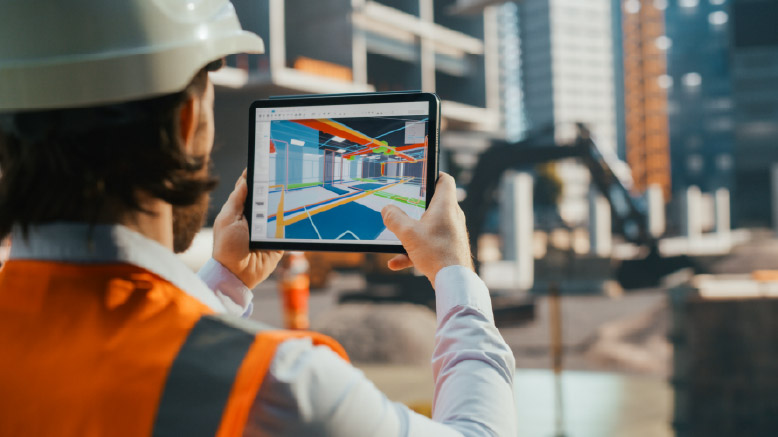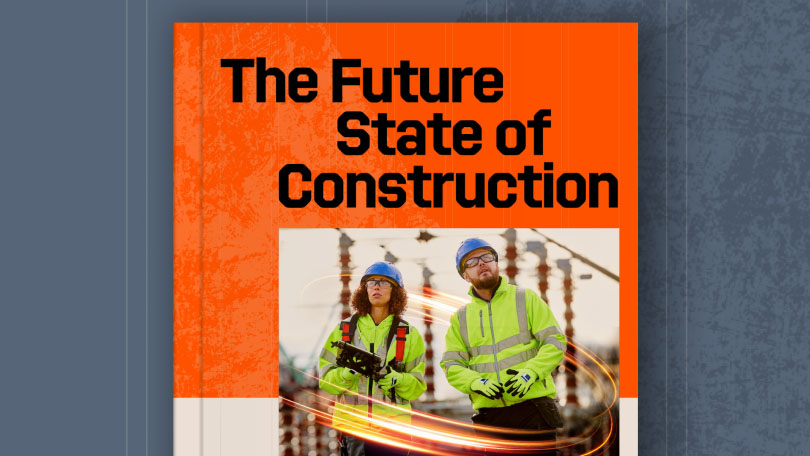— 8 min read
What Are Construction Data Analytics and Why Are They Important?



Last Updated Aug 28, 2025

Nicholas Dunbar
Content Manager
62 articles
Nick Dunbar oversees the creation and management of UK and Ireland educational content at Procore. Previously, he worked as a sustainability writer at the Building Research Establishment and served as a sustainability consultant within the built environment sector. Nick holds degrees in industrial sustainability and environmental sciences and lives in Camden, London.

Federico Selmi
Data Transformation Director
Federico has 20 years experience leading data-driven projects in the real estate, payments, and government sectors. He excels in helping organisations navigate technological changes with a strong foundation in digital product strategy and data implementation. Federico is known for driving efficiency, fostering innovation, and enabling data-driven decision-making across diverse industries. Key Achievements • £3.5bn+ construction projects optimised with real-time data. • Broke down silos and implemented Microsoft Fabric & AI-driven analytics, improving decision-making speed by 80%. • Built high-performing data teams, growing engagement and literacy across 5,000+ employees. • Transformed data governance, reducing inconsistencies by 60% and increasing trust in data. • Scaled fintech Shieldpay from startup to UK’s leading £8bn+ legal payments provider through the use of AI.

Jakir Hyder
Senior Sales and Solutions Consultant
Experienced construction engineer supporting the industry in digital transformation using experience and knowledge gained from Tier 1 contractor through customer focused and outcome based solution design during the presales process.
Last Updated Aug 28, 2025

Imagine being able to pinpoint exactly where a construction project might run into trouble – or how to prevent it altogether. That’s the power of data analytics in construction. Data analytics are essential for collecting, processing, and analysing a construction project and identifying trends, patterns, and opportunities. Without this data, there’s a risk of accumulating unnecessary costs or wasting resources.
We explore the trend of data analytics in the sector, the different sources and benefits of construction data analytics, the concept of big data and how analytics can really shape future projects.
Table of contents
The Rise of Data Analytics
Like most industries, technology adoption in construction is gathering pace to improve safety, budgeting, and output and continues to be an ongoing construction trend.
As construction firms test data analytics, project management is evolving from the traditional ‘waterfall’ approach (completing each stage before moving on to the next stage) to being more agile and data-driven.
According to a global construction survey, the use of AI in the sector (including smarter construction equipment, data and document management) has increased. In 2018, 23% of companies surveyed used it, compared to 37% in 2023. In addition, 42% of companies use basic data analytics across all projects, and 17% use advanced data analytics.
Learn about the future of the built environment - Read Procore's Future State of Construction report
Learn how contractors, subcontractors, and project teams can take advantage of new opportunities to boost efficiency and profitability over the next decade. Download the report to get your roadmap to the future state of construction.

Big Data Analytics in Construction
Big data, which involves gathering and looking closely at a lot of information to find trends and patterns, is key in construction. It helps businesses understand what’s happening and make smarter choices to improve their operations.
And it’s going through rapid growth. As vast amounts of data are created through a project lifecycle, construction companies need to be able to assess such data for future improvements. The data comes from specifications, sensor data, project plans, and equipment logs, creating vast datasets that must be reviewed and analysed.
Research confirmed the importance of big data in construction. Amongst their findings was the study that found big data use ‘enhances a company’s chances of coming up with superior strategic decisions by 69%.’
Applications in Construction
With advanced data analysis tools, construction companies can gain important insights. For example, predictive modelling helps teams foresee potential problems, allowing them to act early. This can apply to everyone from architects to cost estimators, project managers to construction engineers.
Data analysis also improves resource management. By examining labour, materials, and equipment usage, companies can reduce waste and save money. Additionally, it helps streamline work processes by analysing timelines and task dependencies, so site supervisors, contractors and subcontractors can identify and eliminate inefficiencies, boosting productivity.
An integrated software suite can help by providing one clear source of information, making it easier to automate tasks and simplify the construction processes.
Types of Data Analytics in Construction
Various types of analytics are used in construction projects, each with its specific purpose. Here are the most common types:
Descriptive Analytics
This type of analysis looks at historical project data, such as budgets, to highlight trends and patterns from the past. This can help companies spot successful strategies and determine where to improve.
Predictive Analytics
This approach helps to anticipate future trends and events by analysing data such as equipment performance logs. It can be used to estimate how likely a project is to face delays, identify possible risks, or forecast future costs for materials.
Prescriptive Analytics
This more advanced type of analysis predicts what might happen and recommends the best actions to take in different situations, such as adjusting schedules based on real-time data. It helps construction managers make decisions about using resources and scheduling tasks.
Benefits of Construction Data Analytics
Data analytics can benefit various roles within the construction industry by improving efficiency, reducing costs, enhancing decision-making, and boosting overall project outcomes. Here are some benefits of using data in construction, whatever your role:
Managing Costs
By looking at past project data, construction teams can identify where they might be spending too much money. This allows them to use resources more wisely throughout the phases of project management, helping to keep projects on track and within budget. Construction finance, accounting and procurement managers can use data analytics to provide better cost forecasting by analysing historical data on similar projects. This improves the accuracy of cost estimates and can help in identifying cost-saving opportunities from the start.
Through data analytics, supply chain managers can also track material availability, manage inventory levels, and optimise delivery schedules, reducing delays and ensuring cost-effective material procurement.
Safety and Risk Management
Advanced data systems can gather information from devices worn by workers, sensors, and reports about incidents to spot potential safety or risk issues. Safety managers can use data to analyse trends and identify potential hazards on site. Predictive analytics can highlight risky situations, helping to prevent accidents and improve workplace safety. This information can be used to put preventative measures in place to create a safer environment.
Resource Allocation
By observing how resources are being used and tracking productivity, data analytics can assist construction project managers and site supervisors in making better decisions about where to place workers, machines, and materials. For example, if the analysis shows that moving resources to a vital project phase can speed up the entire project, the project manager or site supervisor can make that adjustment for better efficiency.
Collection Options
Data can be collected by wearable technologies, sensors, and Internet of Things (IoT) devices. Sensors can monitor worker productivity and equipment performance, and cloud computing allows storing data and retrieving and analysing historical or real-time data.
While data analytics offer huge benefits, they come with some data integration and quality challenges. Projects generate data from various sources and combining this data can be tricky due to different formats. However, using standardised methods and tools can simplify the process, making it easier to analyse and use the data for decision-making. For example, after construction, data analytics can be used to monitor building performance in real-time. Facility managers can use this data to optimise maintenance schedules, improve energy efficiency, and track operational costs.
Ensuring data accuracy is also vital. Construction data can have errors that affect results. Regular checks and cleaning processes are necessary to fix mistakes and remove duplicates.
Many people want to jump on the bandwagon of data, but they do not understand what data is and why it can be valuable to them...And while the enthusiasm for data is palpable, without a foundational understanding and proper management, the potential of data remains untapped and its true value unrealised.

Federico Selmi
Data Transformation Director
Acumine
How to Implement Data Analytics in Construction
Using construction data effectively requires reliable information and the right tools. Companies may need design software, project management tools, or detailed plans to gather necessary data, along with secure cloud storage. For real-time updates, they might also invest in IoT sensors.
However, it’s not just about having the tools; managers and workers must understand how to use the data. With careful planning and training, businesses can access accurate information and real-time insights, helping decision-makers use data to make informed choices.
Technological Advancements
Unsurprisingly, technology is constantly evolving in the construction industry. Digital transformation advancements include:
- 3D printing: Can increase construction speed, reduce costs and enhance the complexity of architectural shapes.
- Wireless monitoring: Closes the communication gap between equipment and individuals. It gives project managers automatic, real-time updates, allowing improved productivity.
- Autonomous construction: These vehicles, including cranes, perform repetitive or dangerous jobs, reducing risk and allowing skilled workers to do other, more complex tasks.
- Improved finishing materials: Smart concrete and shapeshifting metals can improve functionality and performance, reducing costs and better installation.
- BIM in construction: This can reduce the need for rework as contractors can virtually build a structure before construction. BIM solutions allow projects to keep moving by giving access to 3D models.
Every other industry has some level of tech in it. construction needs to catch up, otherwise we will start having an ever increasing rate of a shrinking workforce.

Jakir Hyder
Senior Sales and Solutions Consultant
Oracle
Regulatory Compliance
In the UK, the growth of digital tools in construction has meant stricter regulatory requirements. Specifically, the ‘golden thread’ stresses the importance of creating accessible, transparent digital records throughout a building’s lifecycle. It forms part of the Building Safety Act and outlines how safety information should be managed and maintained.
Sustainability Initiatives
As we continue to go greener, using data to improve construction practices is becoming increasingly important.
The EN Environment Programme states, ‘The buildings and construction sector is not on track to achieve decarbonisation by 2050. The gap between the actual climate performance of the sector and the decarbonisation pathway is widening.’
Their 2022 Global Status Report confirms that the building and construction industry’s total energy consumption and CO2 emissions increased in 2021 above pre-pandemic levels. Building energy demand has also increased, and CO2 emissions from building operations have reached an all-time high.
Therefore, construction analytics help plan and review building projects to ensure they are more sustainable and less harmful to nature.
The Future of Construction Data Analytics
Big data, AI advancements and real-time data tracking will shape the future of construction analytics. By adopting cloud technologies, contractors can leverage AI and machine learning to create predictive models, enhancing their construction processes.
Data analysis tools also incorporate innovations like virtual reality (VR), augmented reality (AR), AAI, and `IoT. AI and machine learning will continue to help identify patterns and make more accurate project predictions.Data analysis plays a more significant role in the construction industry than ever. By gathering and examining how buildings work, construction companies can use this knowledge to make data-driven decisions to save energy, lower costs, and be more environmentally friendly. Plus, large amounts of data are becoming vital in construction as companies look for ways to make projects more successful, cut expenses, and work more efficiently.
Categories:
Written by

Nicholas Dunbar
Content Manager | Procore
62 articles
Nick Dunbar oversees the creation and management of UK and Ireland educational content at Procore. Previously, he worked as a sustainability writer at the Building Research Establishment and served as a sustainability consultant within the built environment sector. Nick holds degrees in industrial sustainability and environmental sciences and lives in Camden, London.
View profile
Federico Selmi
Data Transformation Director | Acumine
Federico has 20 years experience leading data-driven projects in the real estate, payments, and government sectors. He excels in helping organisations navigate technological changes with a strong foundation in digital product strategy and data implementation. Federico is known for driving efficiency, fostering innovation, and enabling data-driven decision-making across diverse industries. Key Achievements • £3.5bn+ construction projects optimised with real-time data. • Broke down silos and implemented Microsoft Fabric & AI-driven analytics, improving decision-making speed by 80%. • Built high-performing data teams, growing engagement and literacy across 5,000+ employees. • Transformed data governance, reducing inconsistencies by 60% and increasing trust in data. • Scaled fintech Shieldpay from startup to UK’s leading £8bn+ legal payments provider through the use of AI.
View profile
Jakir Hyder
Senior Sales and Solutions Consultant | Oracle
Experienced construction engineer supporting the industry in digital transformation using experience and knowledge gained from Tier 1 contractor through customer focused and outcome based solution design during the presales process.
View profileExplore more helpful resources

Control the Chaos: Standardising Document Workflows in Construction Projects
Document control and implementation play a central role in managing risk, meeting deadlines, and delivering projects to spec. As builds become more complex and teams increasingly disperse, the volume and...

Cost-Plus Construction Contracts in the UK
A construction cost-plus contract – sometimes called a cost-reimbursable or prime cost contract – reimburses all project costs and adds a fee to cover the contractor’s overhead and profit. UK...

Digital Construction Technology for Whole-Life Value
For decades, the construction industry has kept a narrow focus on capital cost — the one-time, upfront costs of a construction project. While in the short term this seems like...

UK Construction Progress Reports: Tools for Smarter Site Management
Construction progress reports track completed work, on site issues, costs, and safety so UK project teams can demonstrate progress, secure payments, and stay on programme. Accurate progress data is essential...
